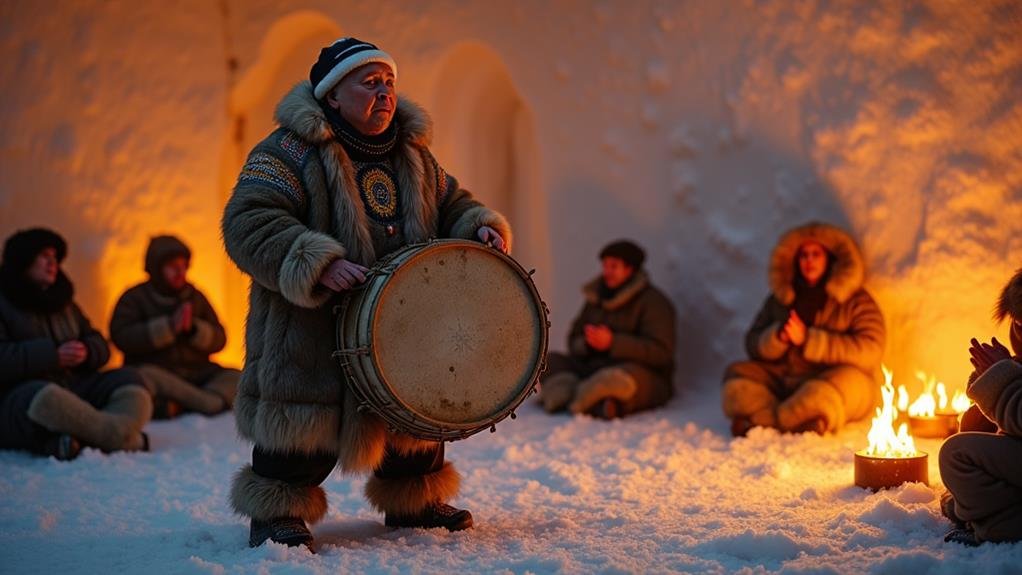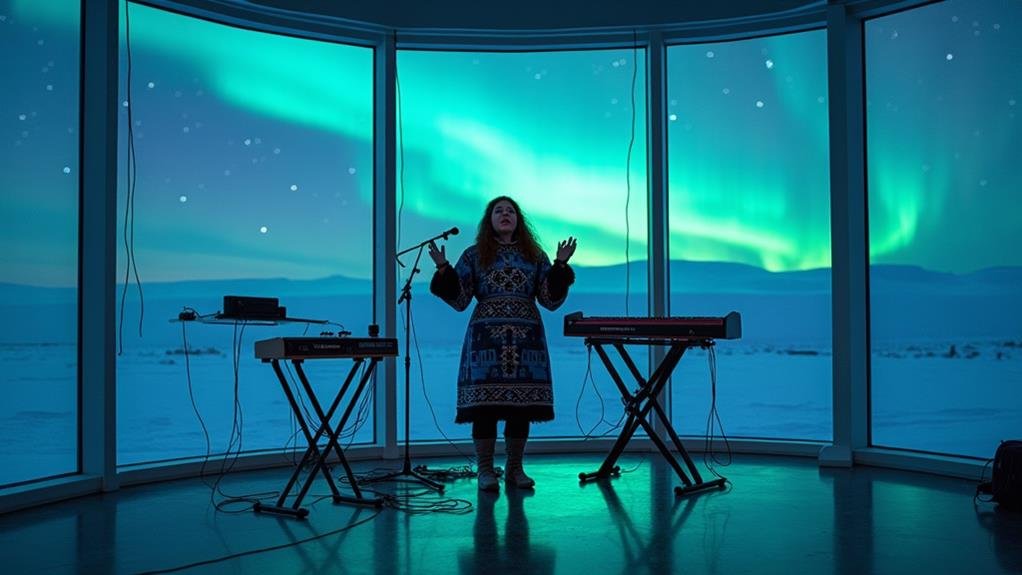Main Points
- Inuit drum dancing and musical traditions serve as vital platforms for storytelling and preserving cultural identity through generations.
- Sacred songs and throat singing demonstrate deep connections to nature and spiritual beliefs within Inuit communities.
- The qilaut drum, made with wooden frames and caribou skin, remains central to traditional Inuit musical expression.
- Traditional performances blend individual and collective expressions through movement, vocals, and rhythmic accompaniment.
- Modern Inuit artists blend ancestral musical elements with contemporary genres while maintaining cultural authenticity and significance.
Origins and Cultural Significance
The Inuit’s musical and dance traditions stand as powerful symbols of their cultural identity, particularly among the Greenlandic Inuit whose practices earned UNESCO recognition in 2021. As a living embodiment of shared heritage, these artistic expressions were designated on UNESCO’s Intangible Cultural Heritage list, acknowledging their profound significance in preserving Inuit culture. At the heart of Inuit music lies drum dancing, which serves as a dynamic platform for storytelling and communal experiences. The qilaut, a traditional drum, creates rhythmic elements that echo the Arctic landscape and accompanies performances that unite generations. These musical gatherings feature themes ranging from love and longing to hunting experiences, reflecting the community’s values and daily life. What makes these traditions particularly meaningful is their inclusive nature, welcoming participants of all ages and genders. This universal accessibility strengthens community engagement while ensuring the preservation of cultural practices. Through drum dancing and singing, the Inuit continue to bridge their past with their present, creating a living archive of their shared heritage that resonates across generations and celebrates their distinct cultural identity.Drums and Traditional Instruments
Central to Inuit musical expression, qilaut drums command profound reverence in traditional performances, featuring wooden frames stretched with caribou skin and played by striking the rim with a specialized stick called a qatuk. These drums produce deep vibrations that resonate through the air, creating powerful rhythmic patterns that guide both singing and dancing in Inuit music. The traditional instrument landscape extends beyond the qilaut to include the tautirut, a bowed zither, and the kelutviaq, a one-string fiddle that showcases the blend of indigenous and external musical influences. While modern adaptations sometimes incorporate synthetic materials in drum construction, the cultural significance of these percussion instruments remains unchanged in contemporary performances. Drummers employ various techniques, manipulating the instrument’s position while using bone or wooden sticks to create sharp, echoing beats. The rhythmic aspects of Inuit music are further enhanced by an array of smaller drums, rattles, and the Jews harp, each contributing distinct tonal qualities to the overall musical experience. These traditional instruments continue to play crucial roles in preserving and expressing Inuit cultural heritage through music.Sacred Songs and Ceremonies

Movement and Performance Techniques
Movement within Inuit performance arts builds upon sacred vocal traditions through intricate choreography and instrumental accompaniment. At the heart of these performances lies the qilaut, a wooden frame drum that provides rhythmic accompaniment for traditional movements. Dancers express themselves by bending their knees and leaning forward, creating a fluid connection between music and motion. Performance techniques in Inuit drum dancing and singing emphasize both individual and collective expression. The integration of collaborative elements, such as choir participation, enriches the overall experience while preserving cultural identity. During festive celebrations and national holidays, these performances showcase:- Solo and group drum dancing that highlights the versatility of traditional movements
- Lyrical narratives that weave together community stories about daily life
- The seamless blend of vocal traditions with instrumental accompaniment
- Dynamic interactions between performers and audience members
Modern Evolution and Preservation

Do Inuit Music and Dance Traditions Reflect the Beauty of the Aurora Borealis?
Inuit music and dance traditions capture the rhythm of Arctic life, resonating deeply with the natural wonders around them. The graceful movements and haunting melodies echo the mystery and majesty of exploring the northern lights, as the culture’s artistic expressions reflect the awe inspired by the vivid celestial displays above.
How Does Inuit Music and Dance Reflect Traditional Inuit Culture and Practices?
Inuit music and dance vividly express the deep connection to nature, spirituality, and community. Through throat singing, drumming, and rhythmic movement, they mirror traditional inuit customs like hunting rituals and seasonal celebrations. These performances preserve the history and values passed down through generations, maintaining a strong cultural identity.


